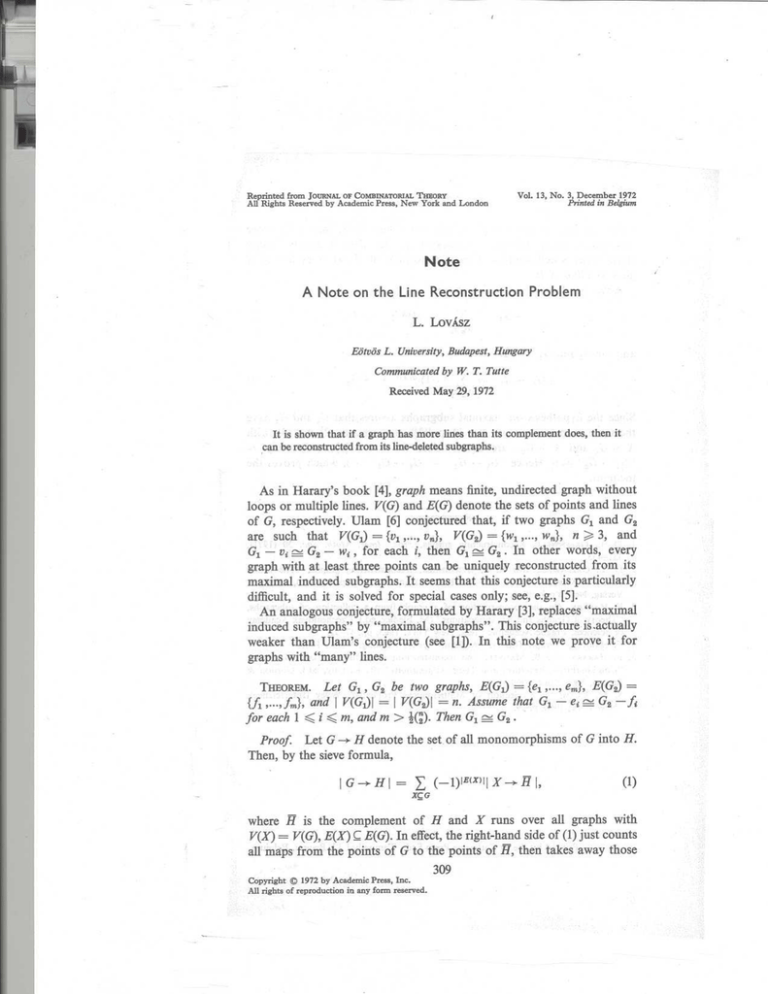
Reprinted from JouRNAL o1 COMBINATORIAL THEORY
All Rights Reserved by Academic Press, New York and London
Vol. 13, No. 3, December 1972
Printed in Belgium
Note
A Note on the Line Reconstruction Problem
L. LovAsz
Eotvos L. University, Budapest, Hungary
Communicated by W. T. Tutte
Received May 29, 1972
It is shown that if a' graphhas more lines than its complement' does, then it
can be reconstructed from its line-deleted subgraphs .;:
As in Harary's book [4], graph means finite, undirected graph without
loops or multiple lines . V(G) and E(G) denote the sets of points and lines
of G, respectively . Ulam [6] conjectured' that, if two graphs G 1 and G 2
are such that V(G1) = {v 1 , . . ., v n}, V(G2) _ {w,_ , . . ., wn}, n > 3, and
G1 - v i = G 2 - wi , for each i, then G1= G2 . In other words, every
graph with ,at least three points can be uniquely reconstructed from its
maximal induced<subgraphs . It seems that this conjecture is particularly
difficult, and it is solved for special cases only ; see, e.g .,' [5] .'
An analogous conjecture, formulated by Harary [3], replaces "maximal
induced subgraphs" by "maximal subgraphs" This conjecture is . actually
weaker than Ulam's conjecture (see [1]) . In this note we prove it for
graphs with "many" lines .
Let G1 , G 2 be two graphs, E(G 1) = {e1, . . ., em}, E(G2) _
and
i V(G) I
I V(G2) I = n . Assume that G1,- ei = G2 -fi
{fl ,..., fm.},
for each 1 < i < m, and m > 2(2) . Then G1 - G2
THEOREM .
Proof. Let G -> H denote the set, of all monomorphisms of G into H.
Then, by the sieve formula,
IG
-*
H
I
= E(-l)IE( x) II X
H I,
(1)
XCG
where H is the complement of H and X runs over all graphs with
V(X) = V(G), E(X) S E(G) . In effect, the right-hand side of (1) just counts
all maps , from the points' of G to the points' of H, then takes away those
309
Copyright Q 1972 by Academic Press, Inc .
All rights of reproduction in any form reserved .
310
LOVASZ
maps sending (at least) one line of G to a line of H, then adds those
sending (at least) two lines to lines of H, etc . Thus it counts exactly
those maps which send no lines of G to lines of H, so every line of G
goes to a line of H .
Applying (1) to G1 and G 2 we have
I
G1
-+
G21
= E
(-1)IE(X)11 X_ 621,
(2)
(- 1)IE(X)II X-+ G2
(3)
XC Gl
and for G 2 and G2 we have
I
G2 -+ G21 =
I
XC G2
Since the hypothesis on maximal subgraphs assures that G 1 and G2 have
the same proper subgraphs (see [2, p . 92]), the terms in (2) and (3), with
X L G1 and X ~ G 2 , are equal . Also, since m > 2(a), I G1-+ 621 =
I G 2 --*
62 I = 0 . Hence I G1 -* G2 I = I G2 - G2 I > 0, which proves the
theorem .
REFERENCES
1 . D. L. GREENWELL, Reconstructing graphs, Proc . Amer. Math. Soc. 30 (1971),
431-433 .
2 . D . L. GREENWELL AND R . L. HEMIVIINGER, Reconstructing graphs, "The Many
3.
4.
5.
6.
Facets of Graph Theory" (G . T . Chartrand and S . F . Kapoor, eds.), SpringerVerlag, New York, 1969.
F. HARARY, On the reconstruction of a graph from a collection of subgraphs,
"Theory of Graphs and Its Applications" (M. Fiedler, ed.), Czechoslovak Academy
of Sciences, Prague/Academic Press, New York, 1965, pp . 47-52 .
F . HARARY, "Graph Theory," Addison-Wesley, Reading, Mass ., 1969 .
F . HARARY AND B . MANVEL, The reconstruction conjecture for labeled graphs,
"Combinatorial Structures and Their Applications" (R . K. Guy, ed .), Gordon &
Breach, New York, 1969 .
S . M . ULA .s, "A Collection of Mathematical Problems," Wiley (Interscience),
New York, 1960, p . 29.
Printed by the St Catherine Press Ltd ., Tempelhof 37, Bruges, Belgium .


